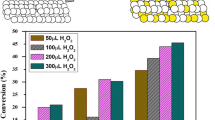Abstract
Nickel oxide promoted catalysts are prepared by simple precipitation, precipitation from homogeneous solution and impregnation methods and their reduction behavior is monitored with temperature programmed reduction (TPR) technique. The effect of different parameters such as metal loading, method of preparation and heat treatment temperature are also observed on the reducibility of the catalysts. It is observed that reduction temperature increases with the increase of calcination temperature. Results indicate that the interactions between nickel oxide and silica begin with the increase of calcination temperature which leads to the formation of nickel hydrosilicates and are responsible for high temperature reduction peaks.
Similar content being viewed by others
References
Gentry SJ, Walsh PT (1982) J Chem Soc Faraday Trans I 78:1515
Jacobs PA, Linart J, Nijs H, Uytterhoeven JB (1977) J Chem Soc Faraday Trans I 73:1745
Afzal M, Khan M, Ahmad H (1991) J Chem Soc Pak 3:619
Afzal M, Khan M, Ahmad H (1991) J Colloid & Polym Sci 2695:483
Wagstaff N, Prins R (1979) J Catal 59:434
Isaacs BH, Peterson EE (1982) 77:43
Jentys A, McHugh BJ, Haller L, Lercher JA (1992) J Phys Chem 96:1324
Lycourghiotis A, Dfosse C, Delannay F, Lamaitre J, Delmon B (1980) J Chem Soc Faraday Trans I 76
Gentry SD, Hurst SW, Jones AM (1981) J Chem Soc Faraday Trans I 77:603
Hurst NW, Gentry SJ, Jones AM, McNicol BD (1982) Catal Rev 24:233
Martin GA, Cephalon N, Montgolfier P (1973) J Chem Phys 70:1422
Ganesan P, DeAngelis RJ, Quality report of surface structure and mechanisms of gasification catalyst deactivation.
Bartholomew CH, Farrauto RJ (1976) J Catal 45:41
Vernon CF, Holn, Alfred C (1968) J Catal 11:306
Bridger GW, Woodward C, Delmon B, Jacobs PA, Ponclete G (1976) Preparation of catalysts. Elsevier Scientific, Amsterdam, p 331
Ercument Z, Falconer L (1982) Applied Catal 365
Bond GC, Sahar PS (1988) Applied Catal 365
Delange JJ, Visser GH (1946) Ingenieur (Utrecht) 58:24
Van EVV, Franzen P (1951) Rec Trav Chim 70:793
Andreas J, Brain J, Gary H, Johanes AL (1992) J Phys Chem 96:1324
Bicek EJ, Kelly G (1967) J Amer Chem Soc Pertoleum. Division Preprints General Papers 12:57
Robertson SD, McNicol BD, DeBass, JH, Kloet SC, Jenkin JW (1975) J Catal 37:424
Unmuth EE, Schwartz LH, Butt JB (1980) 61:242
Reinen D, Selwood PW (1963) J Catal 2:109
Author information
Authors and Affiliations
Rights and permissions
About this article
Cite this article
Afzal, M., Theocharis, C.R. & Karim, S. Temperature programmed reduction of silica supported nickel catalysts. Colloid Polym Sci 271, 1100–1105 (1993). https://doi.org/10.1007/BF00659300
Received:
Accepted:
Issue Date:
DOI: https://doi.org/10.1007/BF00659300




